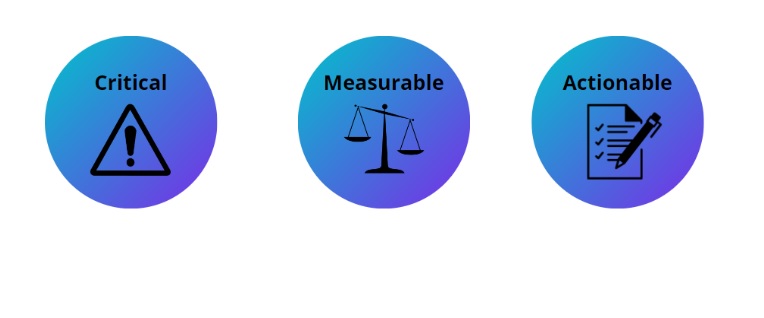
The North Star Metric (NSM) is the single key metric that best defines the core value that your product delivers to customers. However, pairing a NSM with a counter metrics, is most suitable for the proper health of any organization. For example, a B2B business that provides service to other businesses identified its NSM as “Number of signed contracts”. The entire company was committed to pursuing activities to drive and grow the NSM. The leadership, sales, marketing, and product team aimed to grow the number of contracts signed or customers onboarded. The business was also successful in growing the number of contracts signed. However, in the long run, when the overall scene was analyzed, the NSM did not boost the revenue much. This led to poor growth as well as demotivation in the team, as their efforts did not directly transcend results.
So, what went wrong here? The NSM selected was right and it helped the team focus in one big direction. However, it had an unintended side-effect. While all the focus was on growing the number of contracts being signed, what was ignored or overlooked was the ‘deal size’ of these contracts. So along with the NSM, there should be a counter metric that ensures that you don’t miss the key aspects of your business growth by over-optimizing for a single metric. While north star metrics are incredibly valuable for creating focus and alignment, they provide even more value when paired with a counter metric.
What is a Counter Metric?
A counter metric is a metric that ensures that you haven’t over-optimized your business activities as per your North Star metric which may impact or harm other aspects of your business. For every North Star metric, there should be a corresponding counter metric that checks things from going wrong and throws light on areas that would otherwise be hidden under the NSM.
At times a constant increase in the NSM might mislead the organizational goals. As just one metric is tracked and this could lead to a negative trend in other areas, which are often overlooked. Thus, tracking a counter metric will always prevent wrong optimizations and give you a clearer picture.
In the above example of the B2B company, the company was chasing and growing the North Star metric by closing 2x,3x and 4x more customer contracts. The NSM numbers were increasing. However without the counter metric of ‘Average deal size’, the company failed to identify if the closed contracts were of good deal size, and if it was worth the effort that the team was putting in. This issue could have been easily mitigated if a counter metric of ‘Average deal size’ was monitored parallelly along with the North Star metric. Hence, for all the different teams to work together for the success of the business, you would need to have a North Star metric as well as a counter metric.
How to identify your counter metric?
Identifying the right NSM for your business is very critical. Similarly, it is very important to identify the right counter metric for the selected North Start metric.
The purpose of selecting a counter metric is essential for the success of your NSM, as the counter metric provides visibility to areas that you otherwise would lack. So counter metric is also called guardrail or health metrics. As it helps keep your organization on the right track of its business goals and objectives, ensuring that you grow sustainably and healthily.
Hence, you must ensure that the chosen counter metrics is critical to your business. Do not select a vanity metric as your health metric; it will not provide any value for your business and you will not be protecting your business.
Counter metrics should always be measurable. If you are not able to measure your health metric then you have no way to track or improve it. This will greatly affect the health of your organization.
Finally, the counter metrics needs to be actionable. If you are not getting enough insights from your health metric then you wouldn’t know if your organizational activities are in the right direction.

Few examples of counter metrics
Listed below are few North Star metrics and their health metrics:
| North Star Metric | Counter Metric |
| Number of Signed Contracts (B2B) | Average Deal Size |
| Monthly Active Users | Application Usage Frequency |
| Monthly Traffic | Conversion rate |
| Development Velocity | Number of bugs found |
| Ad Revenue | Net Promoter Score |
| Customer Lifetime Value | Customer Acquisition cost |
Success Metric and Health Metric
For the first example that we took of a B2B business, their NSM was the number of signed contracts. This metric gives us the data on the number of contracts that have been signed. However, for the healthy running of the business; there should be a check on the size of the deals that are signed. Hence for the NSM of ‘Number of Signed Contracts’ the counter metric will be ‘Average Deal Size’.
A business whose NSM is ‘Monthly active users’, will give the data on the total active users per month. This metric can be quite misleading. This metric gives info on the active users on the platform. However, it does not give an insight if the users are using the product actively or are just silent users. Though they are on the platform, if they are not using the product, then it indicates the product is not adding value to them. There is a high chance of churning. Hence the counter metric will be ‘Application usage frequency’.
Similarly, if your business NSM is ‘Ad revenue generated per week’. It will give you data on the revenue generated by the ads on your platform. In the process of driving your Ad revenue, you might include too many ads on your pages; ads in the form of pop-ups; or untargeted ads. This might be annoying to your visitors and might make your platform not valuable. This might eventually drive away the visitors from your application. So, to monitor the health of your business/platform you should have a counter metric ‘Net Promoter Score’. This will show you how delighted or disappointed your customers are.
Another, NSM is development velocity. Which is the speed at which features are developed and deployed. For that you need to have a counter metric of ‘Number of bugs found’. This ensures the quality of the deployed feature. Similarly, for a North Star of monthly traffic. The counter metric of conversion rate ensures that the traffic coming in is genuine traffic.
Conclusion
The main purpose of the health metric is to counter your North Star metric. The counter metric keeps a check on the health of your product/business. So always have your product health monitored by the counter metric and not be too much carried away by the success of your North Star Metric.
Always remember that your North Star metric should be chosen based on the value added to customers and how that can be translated to revenue. Whereas, the counter metric should be selected keeping in mind the product’s health. The right NSM and counter metric combination will lead you to get the right insights on your business.


